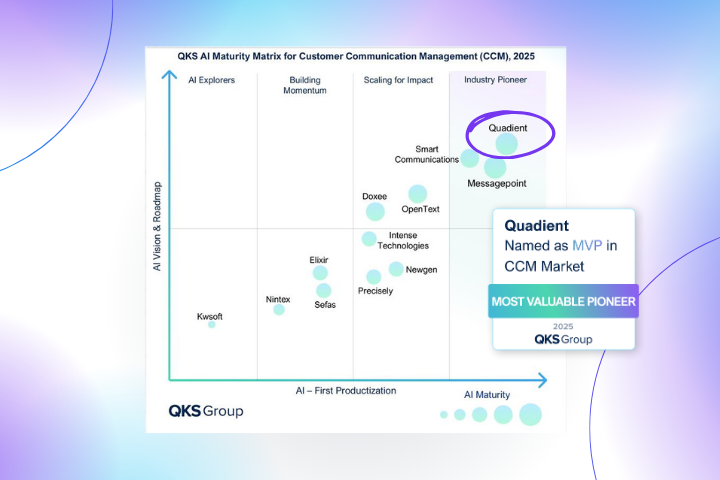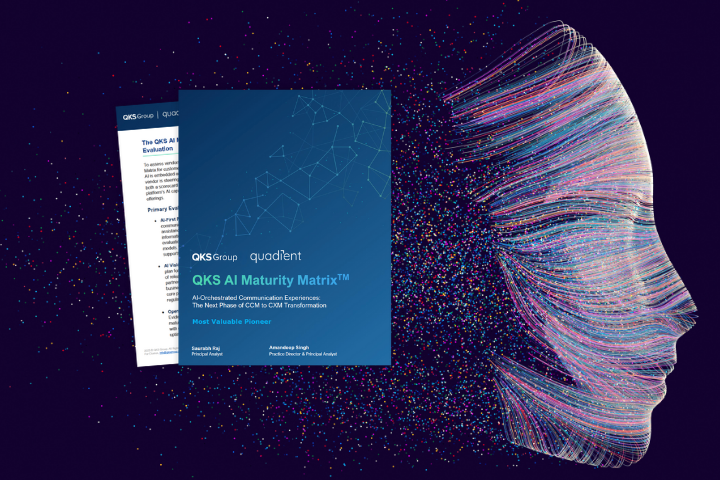
What if your business’s Customer Communications Management (CCM) systems weren’t just outdated, but quietly slowing the speed of business progress and growth? While modern CCM systems are designed to support the orchestration of dynamic customer interactions across print, email, SMS, and web channels, older communication systems were primarily built to support high-volume output of transactional documents. These legacy systems fail to meet modern customer engagement and digital workforce demands, creating costly inefficiencies that have a ripple effect on operations.
Modern solutions not only aim to streamline workflows, but to enable the interactive, omnichannel engagement and operational agility needed to meet evolving customer expectations. Here, we’ll cover common operational challenges and how modern CCM solutions address them, as well as additional capabilities that further enhance communications operations.
Common Operational Challenges Across Industries
If you’d describe your current content management system as “old-school” or even “a little dated,” then the challenges and headaches that come with legacy systems are likely painfully familiar to you. And you’re not alone — roughly 90% of organizations report being hindered by older technologies. What you might not realize is that modern systems solve pretty much every pain point (and are constantly innovating new ways to better address them). These common challenges include:
Challenge 1: Operational Inefficiencies
Older CCM systems aren’t just outdated — they actively hinder operational efficiency and agility. These systems were designed to support the high-volume output of document-based, printed communications versus the real-time, dynamic engagement that customers now expect.
As a result, businesses relying on legacy systems often face:
- IT Dependency: Changes to communication templates or content require IT intervention, creating bottlenecks and slowing the implementation of critical updates and new projects.
- Time-Consuming Manual Updates: Simple tasks like updating a logo or modifying contractual clauses, require repeated changes across multiple templates, increasing the risk of errors and inconsistencies.
- Fragmented Communication Processes: Without centralized management, ensuring brand and messaging consistency across channels becomes nearly impossible, leading to disjointed customer experiences.
- Inflexibility in Scaling Operations: Legacy systems struggle to support fluctuating communication volumes and the integration of new channels, limiting business growth and the ability to meet digital demands.
The Solution: Modern CCM systems simplify operations by introducing a design-once, deliver-everywhere approach. Instead of creating separate designs for each channel, businesses can build a single communication template that automatically generates variations for email, print, SMS, and web. Changes made to the master template are instantly applied across all channels, ensuring consistency and saving significant time.
These systems also shift content management from IT teams to business users, empowering non-technical staff to design, edit, and send communications in real time. This reduces IT costs and dramatically improves the organization’s ability to respond quickly to customer needs, regulatory updates, and business changes.
Additionally, modern solutions leverage AI-driven tools to enhance efficiency and content quality. AI assists with intelligent content analysis, authoring, and optimization, enabling faster production of high-quality, personalized communications at scale. By centralizing workflows and leveraging the power of AI, businesses can achieve greater operational agility and deliver seamless, engaging customer experiences.
Challenge 2: Compliance Risks and Audits
No technology is going to make compliance practices fun, but it doesn’t have to be as tedious as it is with outdated systems. Old-school systems leave a lot of legwork for staff, including constantly trying to track ever-evolving regulatory standards and dealing with time-consuming audits. A recurring theme you’ll find with monotonous, manual work? Errors — which, when it comes to compliance, often result in costly penalties.
The Solution: Modern CCM systems are designed to simplify and enforce compliance by embedding rules and restrictions directly into templates and editing workflows. This ensures communications adhere to regulatory and brand standards through control over how templates can be edited, who can make changes, and what approvals are required.
Key compliance features of modern platforms include:
- Managed Editing Rights and Approvals: Role-based access ensures only designated users can access certain templates and modify certain content blocks, while automated approval workflows guarantee every change is reviewed by the appropriate subject matter expert.
- Automated Content Analysis: AI is seamlessly integrated into template editing workflows to enable the real-time analysis of communications content sentiment and readability, with areas of concerns flagged and actionable recommendations provided to improve quality and compliance.
- Centralized Change Tracking: A clear audit trail of every applied communication update — complete with timestamps and approver details—streamlines the review process during audits.
- Integration with Content Intelligence Tools: Advanced reporting and analytics enrich compliance oversight and performance monitoring, providing deeper insights into communication effectiveness.
- Security-Driven Compliance: Modern platforms meet regulations like HIPAA through built-in security credentials, ensuring data integrity and privacy across all communications.
Challenge 3: Limited Customer Engagement
You already know that every customer is different, so why would a one-size-fits-all CCM platform cut it when it comes to impactful customer engagement? While some legacy systems can support multi-channel communications output, most struggle to deliver a true omnichannel experience. They don’t offer the capabilities needed to adapt to customer channel preferences or ensure seamless integrations across mixed channel methods. All of this leads to one big problem: low customer engagement.
The Solution: With modern CCM systems, businesses can deliver consistent, engaging interactions by combining customer journey insights with omnichannel orchestration. These advanced capabilities provide businesses with the ability to analyze customer behaviors across channels and adapt communication strategies in real time to meet individual needs.
Key enablers include:
- Customer Journey Insights: Customer journey insights reveal how customer communications are positively or negatively impacting the customer experience by providing intelligence such as touchpoints with low engagement rates or where desired customer behaviors fail to be realized. Through direct CCM platform integration, teams can view the communications featured within each touchpoint and assess how changes in the content, channels leveraged, and message timing affect performance.
- Omnichannel Orchestration: Non-technical users can define and automate communication delivery workflows informed by journey insights. These workflows run hands-free and are automatically triggered by real-time customer events. For example:
- A QR code scan, email bounce, or landing page click can trigger pre-defined communication workflows tailored to re-engage customers.
- Adaptive workflows can automatically re-route messages to the channel most likely to reach the customer.
By uniting journey mapping with workflow automation, businesses can transition from insights to action, delivering dynamic, relevant communications that improve customer experience and loyalty — all while enhancing operational efficiency.
The Role of Modern CCM Solutions in Driving Efficiency
Managing a legacy CCM system is a growing challenge for organizations. These aging platforms require constant maintenance, patches, and troubleshooting, which consume IT resources and drive up operational costs. Worse yet, many legacy systems have fallen out of vendor support, leaving businesses without critical security updates or feature enhancements.
Shifting to a modern CCM platform offers a transformative solution with the following benefits:
- Eliminate Infrastructure Barriers: Many organizations struggle with outdated, manual processes and multiple disconnected point solutions, making communication management inefficient and costly. As businesses increasingly look to offload IT hardware costs, they seek solution providers that offer flexibility across on-premises, private cloud, hybrid cloud, and SaaS, with seamless migration paths that reduce disruption to operations during digital transformation. A managed service model ensures continuous optimization and faster speed-to-market for personalized communications.
- Reduce IT Bottlenecks: Legacy systems require IT intervention for even simple updates, slowing response times and creating operational delays. Modern CCM systems shift control to business users, enabling real-time updates without IT dependency. This improves compliance, accelerates customer engagement, and allows IT teams to focus on strategic initiatives.
- Unified Communication Channels: Relying on multiple point solutions leads to inefficiencies, data silos, and inconsistent messaging. A modern omnichannel CCM platform centralizes communications across print, email, SMS, and web, ensuring seamless, automated content delivery. With built-in integrations for additional channels like WhatsApp and member portals, organizations can enhance engagement while reducing complexity.
This shift isn’t just about cost savings or efficiency though — it’s about modernization and leveraging the cutting-edge CX capabilities needed to stay competitive. Modern-based platforms provide access to the latest innovations, enhanced security protocols, and workflow enhancements to future-proof business operations. They also position organizations to adapt quickly to evolving customer expectations and regulatory requirements, enabling a more agile, connected way of working.
Why Organizations Choose Quadient Inspire
By now, you understand the overarching benefits of adopting modern CCM, but those benefits can only be fully enjoyed if you choose the right solution. Here's what makes Quadient Inspire the right end-to-end CCM solution for so many businesses:
- Omnichannel Excellence: Keeping pace with customers’ omnichannel expectations isn’t just about reaching them from multiple channels. It’s also about providing a connected and consistent experience across touchpoints to create positive brand perception. This means leveraging the full breadth of customer data across the customer journey, with seamless data exchange facilitated across interactions. The right CCM solution makes this possible with advanced data integration capabilities that work to maximize messaging relevancy and personalization, making the customer feel individually recognized for enhanced loyalty and satisfaction.
- Proven Migration Success: Quadient Inspire brings proven migration expertise to clients through the use of proprietary tools and methodologies to minimize disruption, reduce migration complexity, and save time. These tools are backed by case studies demonstrating reduced downtime and increased operational efficiency.
- Comprehensive Compliance: Quadient Inspire ensures adherence to industry regulations with features like template-based compliance enforcement, role-based access controls, automated approval workflows, and detailed audit trails. Its AI-powered content analysis highlights errors that could create compliance risks, while integrations with external tools enhance reporting and ensure alignment with evolving standards.
- Scalable for Growth: Inspire Flex offers unmatched scalability with its market-leading AnyPrem deployment model, leading with the highest Overall Strategy score in the global AnyPrem CCM software market on the Aspire CCM-CXM Leaderboard. This flexibility allows organizations to deploy Inspire Flex on-premise, in a public or private cloud, or as a hosted managed service, with seamless migration paths to Inspire Evolve for future SaaS adoption. Inspire Flex is built from modular components—such as Scaler, Interactive, Designer, and Omnichannel Orchestration (OCO)—that can be deployed individually or together to custom-configure your CCM solution to meet current and future requirements.
- Ongoing Customer Support: Some CCM providers make a sale and then leave you to fend for yourself. With Quadient, you gain access to ongoing support, including resources like Quadient University, user communities, and training programs to ensure success every step of the way.
Exceptional Customer Satisfaction: Quadient Inspire has a 98% satisfaction rate, with 97% of customers recommending the platform, meaning it’s been tested and verified by businesses just like yours.
From Outdated Systems to Leading Solutions
Transitioning to a modern CCM solution like Quadient Inspire isn’t just about replacing outdated systems — it’s about transforming operations, enhancing efficiency, and empowering organizations to meet future challenges head-on.
Ready to upgrade your CCM system? Explore Quadient Inspire and discover how it can elevate your operations.







